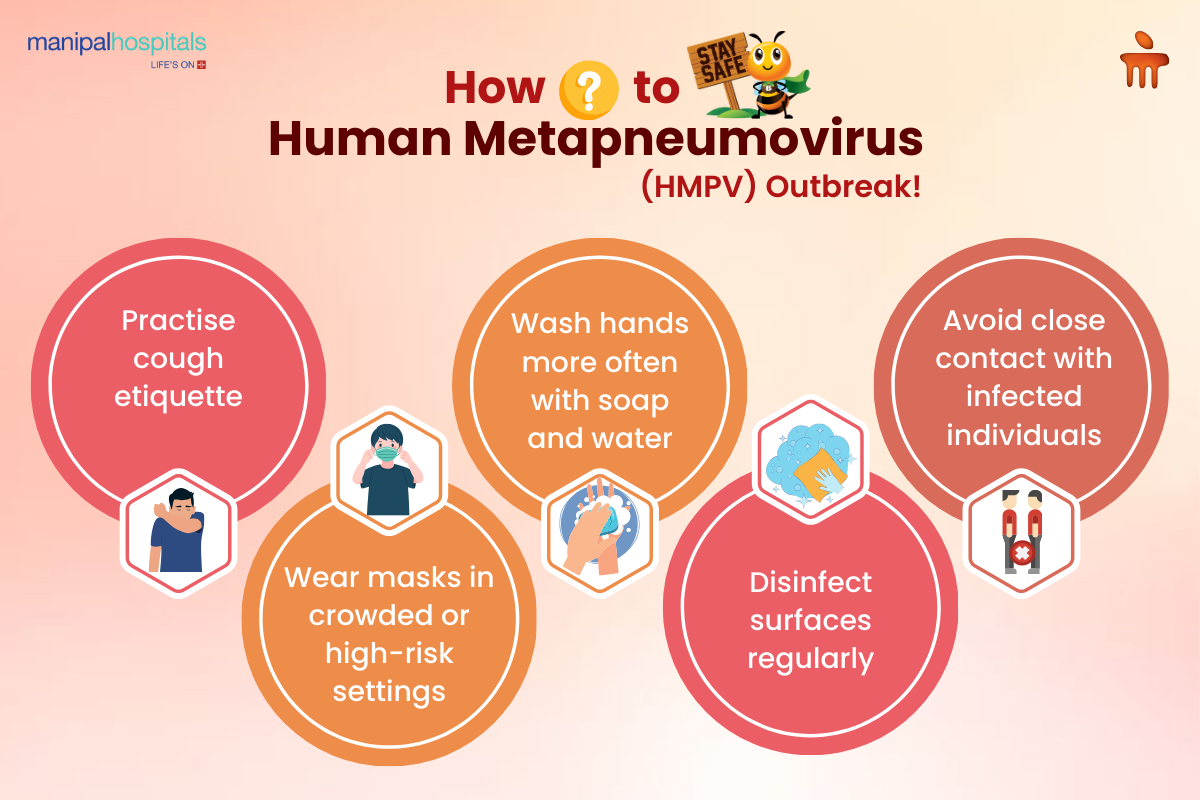
Listen to article
Loading audio...
A surge in Human Metapneumovirus (HMPV) cases in China greatly concerns public health, especially as it spreads to other parts of the world, including India and neighbouring countries. Known as HMPV, the virus causes symptoms such as a sore throat, a fever, a runny nose, and all the complications associated with the common cold or flu. While most cases cause only mild illness, it can lead to severe respiratory infections in young children, the elderly, or people with weakened immune systems. In this blog, let’s explore how to stay safe from HMPV.
Synopsis
What is HMPV?
HMPV is a respiratory virus that passes through respiratory droplets, such as direct contact with an infected individual, medical waste, bodily fluids, or contaminated surfaces. Its incubation period usually takes three or six days after exposure. Symptoms typically involve cough, fever, nasal congestion, and sore throat.
HMPV can be severe in young children and the elderly, resulting in bronchiolitis or pneumonia. There is no particular antiviral treatment or vaccine for HMPV, and its management consists only of supportive care to alleviate its symptoms.
Public Health Concerns and Rising Cases
HMPV cases have increased attention because of their effect on vulnerable people. HMPV isn’t a new virus but has gained increased prominence because of heightened awareness and better diagnostic capabilities, which has also meant more often cases have been identified.
Please note that - HMPV is a known pathogen with known seasonal patterns and that the current rise in cases doesn’t signal an impending pandemic like COVID-19.
HMPV Symptoms
HMPV symptoms mirror 'common respiratory illnesses' and range from mild to severe.
The most common symptoms of HMPV include:
-
Fever
-
Nasal congestion
-
Sore throat
-
Wheezing
Serious complications, such as bronchiolitis or pneumonia, are rare and occur most commonly in severe cases (especially among young children, the elderly, or those with weakened immune systems).
The main symptoms usually start 3 to 6 days after exposure to the virus. Most cases resolve themselves, but people with severe symptoms or underlying health conditions should immediately see a doctor to manage complications and avoid further health risks.
Recent HMPV Outbreaks in China and India
Infections with HMPV have increased in China in recent times, especially among children up to the age of 14. Hospital cases of both HMPV and respiratory illness have also increased. However, Chinese health authorities have said that this rise corresponds with typical seasonal trends and poses no unusual threat to public health.
So far, 15 cases of HMPV have been confirmed in Mumbai, Bengaluru, Nagpur, Tamil Nadu, and Ahmedabad. Patients in these cases, who are mainly children from 3 months to 8 years old, are often infected with these agents. Public health authorities have reassured the public that it's not a crisis on the scale of the COVID-19 pandemic.
Preventive Measures for HMPV

Meanwhile, health authorities in both China and India have reassured the public that the HMPV situation is under control. The Ministry of Health and Family Welfare (MoHFW) of India is closely monitoring the situation and said that hospitals are well prepared to handle the expected peak in respiratory infections that appear during winter in the country.
The Indian Council of Medical Research (ICMR) is also expanding the number of laboratories conducting HMPV tests and will monitor trends throughout the year. Health officials said the situation remains under anticipated seasonal patterns and urged people not to panic.
The public is advised to follow standard health precautions for HMPV, including:
-
Hand Hygiene: Wash hands frequently with soap and water for at least 20 seconds.
-
Respiratory Etiquette: Cover your mouth and nose with a tissue or elbow when you cough or sneeze.
-
Avoid Close Contact: Keep distance from people with suspected respiratory illness.
-
Stay Home When Ill: Stay home if you are symptomatic to prevent the spread of the disease.
Conclusion
Health authorities say public health should not be alarmed by the onset of HMPV cases in China and India in recent weeks, although they claim to have risen to levels not seen for more than a decade. The situation follows the usual seasonal pattern. Staying safe depends on learning about HMPV and how to prevent it. Practices such as good hygiene and seeing your pulmonologist in Jayanagar, Bangalore, if you are sick can keep you from passing HMPV along to your community.
FAQ's
Human Metapneumovirus (HMPV) is a respiratory virus that causes cough, fever, and runny nose. Its symptoms can sometimes be indistinguishable from those of the common cold or flu. In the young, the elderly, and patients with weakened immune systems, HMPV can result in severe respiratory conditions.
HMPV is spread through respiratory droplets, direct contact with an infectious person, or contact with contaminated objects.
At this point, no specific antiviral treatment or vaccine for HMPV is known. Management focuses on supportive care to relieve symptoms. Reducing the risk of infection requires preventive measures, such as good hand hygiene and avoiding close contact with infected individuals.



















 4 Min Read
4 Min Read















